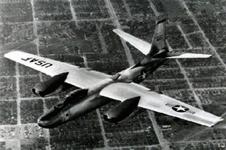


RB-45 Tornado
At the end of 1944, the US Army issued a design competition for a jet-powered bomber. This urgent requirement given to aircraft manufacturers was precipitated by the discovery of secret documents and actual German jet aircraft captured during World War II. The first two American jet bombers produced were the North American B-45 Tornado and the Convair XB-46. The B-45 filled a critical gap in the US defense posture. As an Air Force bomber, it saw limited service with the Tactical Air Command during the 1950s and served well as a reconnaissance aircraft during the Korean war. The reconnaissance models were designated RB-45Cs and assigned to the Strategic Air Command. The Tornado also performed classified, deep penetration photographic intelligence missions over many cold war communist countries. The reconnaissance version of the B-45 became the forerunner of the U-2 and SR-71 surveillance aircraft.
The Air Force took initial delivery of the RB-45C in June 1950, and the RB-45Cs were earmarked primarily for SAC. The Command's inventory reached a peak of 38 aircraft in 1951, some B-45s being included in this total. However, no B/RB-45 aircraft remained in the SAC inventory by 1953. This did not spell the RB-45's end, as the aircraft went to other commands. By mid-1959 only 1 RC-45C remained in the Air Force inventory.
On August 26, 1950, SAC's first RB-45, a "C" model, four-engine jet reconnaissance aircraft was delivered to the 91st Strategic Reconnaissance Wing at Barksdale AFB, Louisiana. Effective November 16, 1950, the 91st Strategic Reconnaissance Squadron moved from Barksdale AFB, Louisiana to Yokota AB, Japan. The 91st absorbed personnel and aircraft of the 31st Strategic Reconnaissance Squadron, which returned to Travis AFB, California. Arrival of the RB-45s was well timed, as the RB-29s of the 91st Strategic Reconnaissance Squadron were no longer able to perform with impunity the special missions ordered by Far East Air Force or the targeting and bomb-damage assessment photography desired by its Bomber Command. Eager to maintain its reconnaissance capability in the face of the Soviet-built MiG jets, Bomber Command on January 31, 1951 took control of the RB-45 detachment and attached it to the 91st Squadron. The RB-45 crews managed to outrun and outmaneuver the MiGs for several months. On April 9, 1951, one of the too few RB-45s barely escaped a numerically far superior enemy.

Sources and Methods
http://www.fas.org/irp/program/collect/rb-45.htm
Created by John Pike
Maintained by Steven Aftergood
Updated Wednesday, March 10, 1999 5:37:54 PM






